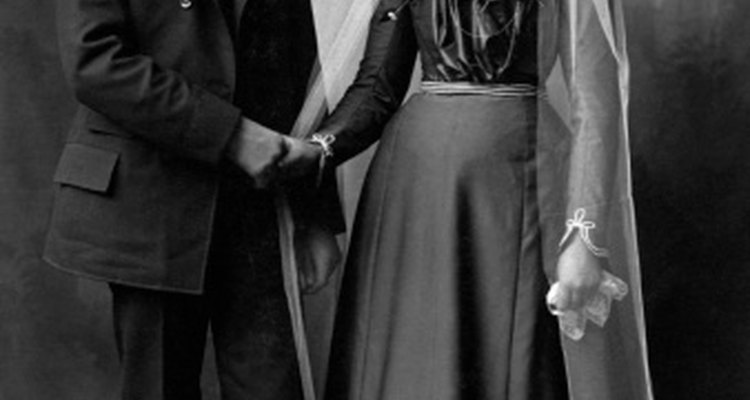
During the 19th century, women were expected to dress and behave according to certain social standards. Though dresses were generally fashioned with high necks, long sleeves and long skirts to maintain a woman’s modesty, the types of dresses worn depended on class. A woman’s wealth was apparent from the clothes she wore, and farmers’ wives generally donned simple dresses practical for the work demanded of them.
Dresses
Unlike their urban contemporaries, women in rural areas -- including farmers’ wives -- wore simple dresses made from wool or linen. A white collar was usually the only adornment, over patterns of gingham checks and small flowers known as calico. City ladies, by contrast, predominantly wore paisleys, florals and wide stripes. Moreover, farm wives usually owned just one work dress and one better dress, both of which featured straighter skirts than those worn by upper-class women. These dresses composed a country woman’s wardrobe until they fell apart, at which point they were converted into children’s clothes or household rags.
Accessories
Affluent women often accessorized with gloves, jewelry, muffs and parasols, but farmers’ wives wore only cloaks or shawls with their dresses. Cloaks, prominently worn in England, were often red and sometimes had a hood of cloth or wool. Farmers’ wives wore these during the week when visiting with friends. Shawls were common adornments on Sundays. Between 1820 and 1840, during the cloak’s waning years, this garment was worn primarily by elderly women. Farmers’ wives also wore aprons over their dresses to protect them from the dirt that accompanied daily housework. In addition to helping with farm work, they were conscientious about their homes and did a lot of cooking and cleaning. They donned clean aprons, similar to shawls, on Sundays for a more flattering appearance.
Headwear
In step with 1800s traditions, farmers’ wives usually had long hair worn in a simple bun for daily activities. Traditional hats included the bonnet or sunbonnet to protect a woman’s face from the elements. Bonnets had deep brims and tied under the chin. In England, farm wives wore straw hats they made themselves from wheat.
Undergarments
Farm wives in the 19th century wore undergarments very similar to those of upper-class women. These clothing articles included a chemise to protect the dress from perspiration, drawers that reached just below the knees and a corset or stays. Stays and corsets were worn over the chemise to provide the desired hourglass figure of that time. The greatest variance in undergarments between farm and city women was visible with petticoats. Farmers’ wives usually wore only one or two; upper-class women wore more. Stockings completed the list of undergarments, reaching above the knee with a knitted or crocheted garter to hold them in place.
Related Articles
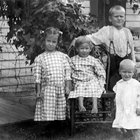
Children's Clothing From the 1920s

What Do Women Pirates Wear?
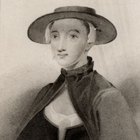
Women's Hats in the 1700s
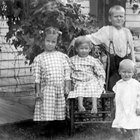
Children's Clothes in 1915
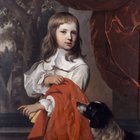
Children's Clothes in the 1600s
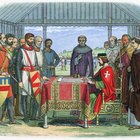
Kids' Clothing During the Medieval ...
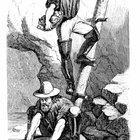
Clothing of the Gold Miners in the 1850s
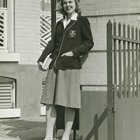
School Uniforms in the 1940s
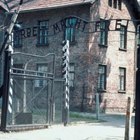
Clothing of the Children During the ...

Hat Trends of the Seventies
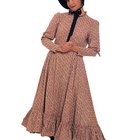
How to Dress Up for "Old Fashioned Day" ...

What Teenagers Wore in the 1940s
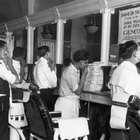
Men's Fashion of the 1930s
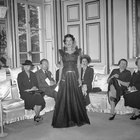
What Type of Clothes Did Women Wear ...
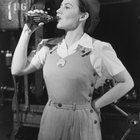
Women's Clothes in 1943
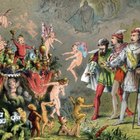
What Did Men Wear During the ...

Traditional Roles of Men & Women in ...
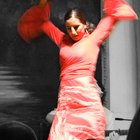
Hispanic Clothing History

Children's Clothing of the 1800s
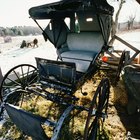
What Do the English Wear to an Amish ...
References
- Damsels in Regress; Women and Children: From Shoulder to Ankle; Feb. 17, 2010
- System for Adult Basic Education Support: Early Industry 1800-1900
- "Beloit Daily News"; Local Woman Sews Dresses Dating Back to 1800s; Hillary Garan; July 17, 2010
- Hardscrabble Farm; Guideline for a Rural Southern Impression; Brian Mead; 2003
Writer Bio
Jean Miller has been writing since 2008. As a freelance writer, she has developed website content, press releases and newsletters for a variety of clients. Miller holds a Bachelor of Business Administration in human resource management from Cleary University.
Photo Credits
Jupiterimages/Comstock/Getty Images